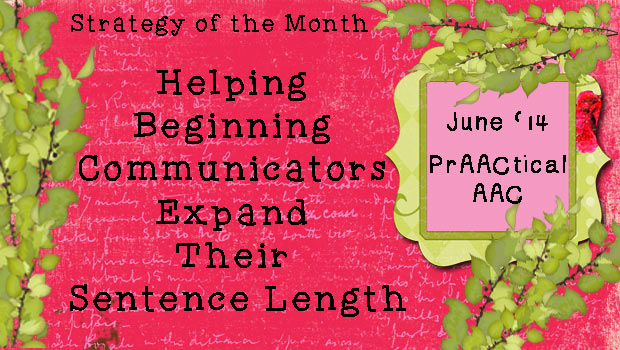Helping Beginning Communicators Expand Their Sentence Length

Nothing makes an AAC SLP happier than seeing beginning communicators start to use symbols to express themselves. Sure, it is great when a learner grabs your arm to lead you to the snack cupboard or hands you a juice box to get help opening it. Those are important communicative acts that we celebrate. But moving beyond pre-symbolic forms of communication to using signs and pictures, allows us to expand their vocabularies outside of the ‘here and now’ and enables them to communicate effectively with less familiar partners. When we’ve crossed the bridge into symbolic communication, we’re building a foundation for language development. If things go well, the learner will steadily acquire new symbols and words, eventually allowing us to work on word combinations.
Are you working with AAC learners who at the early sentence level? If so, you may be considering how to build the length and complexity of their utterances. In some ways, this is no different than the strategies you would use with speaking children at this level. Here are some things to think about as you proceed.
1. Add-A-Word: Respond to any communicative attempt by adding a single word to whatever the communicator says (E.g., “More” becomes “Want more;” “Want more” becomes “Want more milk;” “Want more milk” becomes “I want more milk”).
2. Focus on a specific target: Maximize your therapy effectiveness by knowing exactly HOW you want the AAC learner to increase sentence length. Are you going for more verbs? Adding descriptors? Using pronouns? Which ones? Get specific so that you can teach that particular word, model sentences with that kind of word, and provide many practice opportunities on that specific word type.
3. Tempt a longer utterance and scaffold: A learner who is used to 2-word sentences (e.g., “want cracker”) will probably need help building up the length. One way to do that is to have options that relate to the initial request, such as a big piece of cracker and a little piece of cracker if I am trying to expand the sentence with a descriptor.
- “Want cracker”
- “Big or little””
- “Big”
- “Want big cracker”
4. Respond contingently: As soon as the learner produces the target utterance, respond to the intent (not the form).
- “Want more milk” should result in getting more milk, not a comment on ‘good talking’ or ‘saying the whole thing.’
- “Want go to the store” should result on an acknowledgement even if you can’t comply with the request (e.g., “Tomorrow. We can go to the store tomorrow.”)
5. Model the longer utterance with aided language input: Always a critical strategy for beginning communicators, this is something we highly recommend until the learner is familiar with his/her AAC system and uses it fluently.
6. Repeat in various contexts: Learners gain skills more quickly when we provide a lot of instruction with different materials and in various activities.
7. Consider changing the communicative function: Don’t restrict the learner to using longer utterances for just one purpose. Beginning with requests may be a good idea for some learners, but once they get the hang of it broaden out to using longer sentences for protesting (e.g., “No more” becomes “No more milk”) or commenting (e.g., “See car” becomes “See red car”).
8. Individualize: Many beginning communicators are motivated by requests for things they want or activities they want to do. That wasn’t the case for Jonah, however. This little guy was much more motivated by social interaction, attention, and connecting with other people just for the joy of it. It’s not always about ‘the stuff.’ For Jonah, some initial targets could be:
- “Go” to “Go see;” Then “Go see Carly” or “Me go see”
- “Play” to “Play now;” Then “Me play now” or “Carly play now”
9. Spread the news: Share the specific goal that the learner is working on so that others can facilitate the process and take note of attempts to use the longer sentence. We build generalization through planning and teamwork, not just doing our intervention and ‘hoping’ the skill generalizes.
We’d love to hear your thoughts on helping beginning communicators build longer sentences.
Filed under: Strategy of the Month
This post was written by Carole Zangari

1 Comment